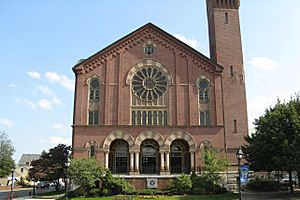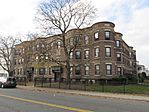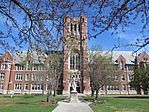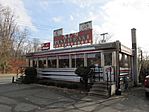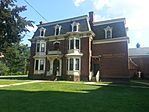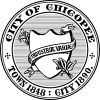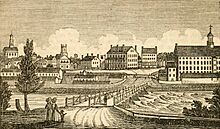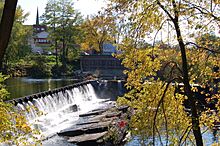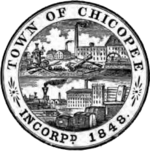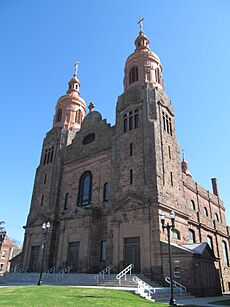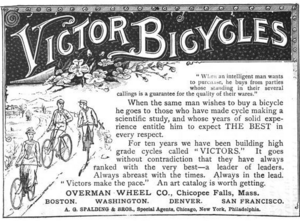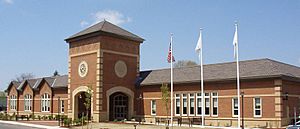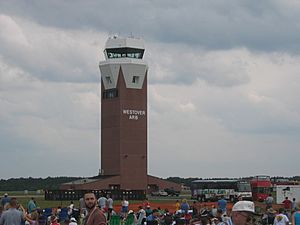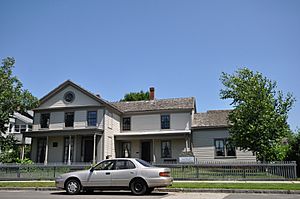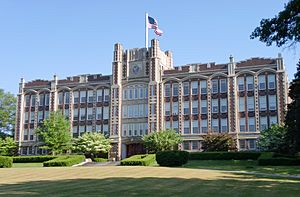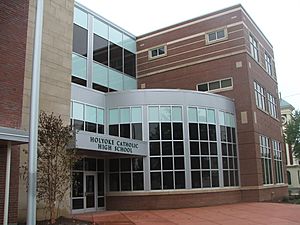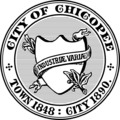Chicopee, Massachusetts facts for kids
Quick facts for kids
Chicopee, Massachusetts
|
|||
|---|---|---|---|
|
Clockwise from top: Chicopee City Hall, Berchmans Hall at College of Our Lady of the Elms, the Polish Center of Discovery and Learning, Al's Diner, and the Carreau Block
|
|||
|
|||
| Nicknames:
Crossroads of New England
Kielbasa Capital of the World |
|||
| Motto(s):
Industriæ Variæ (Latin)
"Varied Industries" |
|||
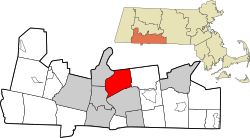
Location in Hampden County in Massachusetts
|
|||
| Country | |||
| State | |||
| County | Hampden | ||
| Settled | 1640 | ||
| Incorporated (parish) | June 11, 1751 | ||
| Incorporated (town) | April 29, 1848 | ||
| Incorporated (city) | April 18, 1890 | ||
| Government | |||
| • Type | Mayor–council city | ||
| Area | |||
| • Total | 23.87 sq mi (61.83 km2) | ||
| • Land | 22.91 sq mi (59.33 km2) | ||
| • Water | 0.97 sq mi (2.50 km2) | ||
| Elevation | 200 ft (61 m) | ||
| Population
(2020)
|
|||
| • Total | 55,560 | ||
| • Density | 2,425.57/sq mi (936.53/km2) | ||
| Time zone | UTC−05:00 (Eastern) | ||
| • Summer (DST) | UTC−04:00 (Eastern) | ||
| ZIP Codes |
01013, 01020–01022
|
||
| Area code(s) | 413 | ||
| FIPS code | 25-13660 | ||
| GNIS feature ID | 0617597 | ||
| Website | www.chicopeema.gov | ||
Chicopee is a city in Hampden County, Massachusetts, United States. It sits along the Connecticut River. In 2020, about 55,560 people lived there. This makes it the second-largest city in western Massachusetts, right after Springfield. Chicopee is part of the larger Springfield area.
Chicopee is known as the "Crossroads of New England". This nickname shows how important its location is. Many major highways, like I-90, I-91, I-291, and I-391, pass through the city.
The city grew around several old mill towns on the Chicopee River. In the 1800s, Chicopee was a hub for new industries. It was home to the first American company to make friction matches. The Ames Manufacturing Company here made many tools and was the biggest producer of swords for the Union Army during the Civil War. Later, companies like Fisk Tire Company (a big tire maker) and A. G. Spalding (sporting goods) had factories in Chicopee.
Today, Chicopee has many special manufacturing businesses. It is also home to Westover Air Reserve Base. This is the largest Air Force Reserve Base in the United States. It was built in 1940, just before World War II.
Contents
History of Chicopee
What Does "Chicopee" Mean?
The name "Chicopee" comes from the Nipmuc language. It likely means "violently" (referring to water) or "of red cedar." Over time, the spelling of the name has changed a few times.
Early Settlements: Cabotville and Chicopee Falls
In 1636, William Pynchon bought land from the Agawam Indians. This land is now part of Chicopee Center (Cabotville). Both Cabotville and Chicopee Falls grew into busy manufacturing towns.
The area above the falls was first settled around 1660. The land was divided into districts. Nayasett, meaning "at the small point," was the name for what is now Chicopee Center and Chicopee Falls. The first industrial site was a sawmill built in 1678 at Skenungonuck Falls (now Chicopee Falls).
By 1786, a place called Factory Village started to grow. Ten local men agreed to build an iron factory there, and it became very successful.
In 1823, Jonathan Dwight bought the water rights at Skenungonuck Falls. He built a textile mill that became the second-largest in Massachusetts. By 1831, two huge dams and two water canals were built on the Chicopee River. This helped power many factories.
Many companies from the Chicopee River area became famous worldwide. These included Ames, Belcher, Lamb, Dwight, Stevens, Spalding, Fisk, and Duryea.
Becoming Separate from Springfield
In the 1740s, people in the Chicopee area wanted their own church. They had to travel far to the main church in Springfield. In 1750, they asked to form their own church parish, and this was approved in 1751. This was the first step for Chicopee to become separate from Springfield.
In 1844, the people of Chicopee tried to become their own town, but Springfield disagreed. In 1848, Springfield wanted to become a city. Many Chicopee residents did not want this because it would cost more money. So, 700 people from Chicopee's neighborhoods signed a petition to form their own town.
The government approved Chicopee's request on April 25, 1848. Governor George N. Briggs signed the act on April 29, 1848, officially creating the Town of Chicopee. The first town meeting was held on May 17, 1848.
Becoming a City
On April 18, 1890, Chicopee officially became a city. George Sylvester Taylor became Chicopee's first mayor on January 5, 1891.
Westover Air Reserve Base was built in 1940. It was first called Westover Field and was an Army Air Corps base. In 1948, it became Westover Air Force Base. Since 1974, it has been an Air Force Reserve base. It is the largest Air Force Reserve base in the United States.
In 1991, St. Stanislaus Bishop and Martyr Church was named a minor basilica by Pope John Paul II.
Chicopee's Industries
Chicopee's motto is "Industriae Variae," which means "Various Industries." This shows the many types of businesses that have been in the city. Chicopee had factories for cotton, wool, and other textiles. It also had factories that made brass and iron, paper, leather shoes, and even ships. The first friction matches were made here.
The Ames Manufacturing Company made many machines and bronze cannons. They also made more swords than any other American company at the time. Ames created famous bronze statues, like the one of President George Washington in Boston. During the Civil War, Ames was a main supplier of cannons to the Union army. The Stevens Arms factory made many rifles for the British during World War II. Chicopee was also where the first gasoline-powered automobile in the United States was built by the Duryea company.
Bicycles Made in Chicopee
In the late 1800s, Chicopee Falls became a big center for making bicycles. Two major bicycle factories were located here: The Overman Wheel Company (from 1882 to about 1899) and the Spalding sporting goods company.
Albert H. Overman moved his bicycle factory to Chicopee Falls in 1883. His company grew quickly because safety bicycles became very popular in the 1890s. At its busiest in 1894, Overman's factory had over 1,200 workers. However, too many bicycles were made, and prices dropped. By 1901, the Overman company closed.
Chicopee Public Library
The Chicopee Public Library started from a group called the Cabot Institute in 1846. In 1853, this group decided to give their books to the town. This made it the first public library in Western Massachusetts that was paid for by the local community.
Geography and Neighborhoods
Chicopee is made up of several neighborhoods. These were once four separate villages that joined together. These original villages were Chicopee Falls, Chicopee Center (Cabotville), Fairview, and Willimansett. Later, Aldenville also grew into its own community. Over time, new neighborhoods like Chicomansett, Ferry Lane, Sandy Hill, and Burnett Road have also developed.
Chicopee is surrounded by other towns and cities. To the northwest is Holyoke, to the southwest is West Springfield, and to the south is Springfield. The city is about 89 miles (143 km) from Boston and 140 miles (225 km) from New York City.
The city covers about 23.9 square miles (61.8 square kilometers). Most of this is land, with about 1.0 square mile (2.5 square kilometers) being water. The Chicopee River flows through the southern part of the city and into the Connecticut River. Many ponds, lakes, and streams are also found here.
Willimansett Neighborhood
In 1641, William Pynchon bought more land, extending north to the Willimansett Brook. "Willimansett" means "good berries place" or "place of red earth" in Nipmuc. The first homes were built here in the 1660s and 1670s by the Chapin family.
By the late 1800s, the city decided to build the Willimansett Bridge. This bridge connected Willimansett with Holyoke across the Connecticut River. This was a big change, and Willimansett and Aldenville became closely linked to Holyoke.
By the 1900s, Willimansett had many French Canadian residents. Chicopee became four distinct areas, each with its own groups of people and interests.
The Smith Highlands area, between Fairview and Willimansett, used to have its own school and bus service. Robert's Pond was a popular swimming spot in the summer, and the fields where Bellamy Junior High School is now were great for sledding and skiing in winter.
Fairview Neighborhood
Fairview is the northernmost neighborhood in Chicopee. It once included the land where Westover Air Reserve Base is now. Fairview was mostly farmland, known for its tobacco farms. After 1939, Westover helped Fairview grow quickly into a residential and business area.
Aldenville Neighborhood
On August 18, 1870, Edward Monroe Alden bought 600 acres of land east of Willimansett. He wanted to create a "little city on the hill," which became Aldenville. In 1890, he started planning streets and dividing the land into lots. French-Canadian factory workers from Chicopee Falls, Cabotville, and Holyoke began to build homes here. The first house was bought and built by Marcellin Croteau, a French-Canadian builder.
Population Information
| Historical population | ||
|---|---|---|
| Year | Pop. | ±% |
| 1850 | 8,291 | — |
| 1860 | 7,261 | −12.4% |
| 1870 | 9,607 | +32.3% |
| 1880 | 11,286 | +17.5% |
| 1890 | 14,050 | +24.5% |
| 1900 | 19,167 | +36.4% |
| 1910 | 25,401 | +32.5% |
| 1920 | 36,214 | +42.6% |
| 1930 | 43,930 | +21.3% |
| 1940 | 41,664 | −5.2% |
| 1950 | 49,211 | +18.1% |
| 1960 | 61,553 | +25.1% |
| 1970 | 66,676 | +8.3% |
| 1980 | 55,112 | −17.3% |
| 1990 | 56,632 | +2.8% |
| 2000 | 54,653 | −3.5% |
| 2010 | 55,298 | +1.2% |
| 2020 | 55,560 | +0.5% |
| 2022* | 54,980 | −1.0% |
| * = population estimate. Source: United States Census records and Population Estimates Program data. Source: |
||
In 2010, the population of Chicopee was mostly white (75%). About 18.5% of the people were Hispanic or Latino, 3.1% were Black, and 1.6% were Asian.
In 2000, there were 54,653 people living in Chicopee. About 26.5% of households had children under 18. The average household had 2.32 people. The median age in the city was 39 years old.
Economy and Businesses
Chicopee's economy is mostly based on services. It has a mix of small local businesses and larger national companies. The city is also known for its Polish-American food makers. These include Chicopee Provision Company, which makes kielbasa (Polish sausage), Millie's Pierogi, which makes traditional Polish dumplings, and Domin & Sons, a big producer of horseradish.
Even with changes in the world economy, Chicopee still has manufacturing. Callaway Golf makes over 5 million golf balls each year at its factory in Willimansett. Since 2013, the Chemex Corporation, which makes the famous Chemex pour-over coffeemaker, has been based in Chicopee. The Buxton Company, which designs and sells leather goods and gifts, is also located here.
Chicopee also has several financial businesses. These include Alden Credit Union, The Polish National Credit Union, and Chicopee Savings Bank. The Chicopee River Business Park and Westover Business Park are important business areas in the city.
Arts and Culture in Chicopee
Fun Events to Attend
- The Great New England Air Show is a two-day event held every year at Westover Air Reserve Base. It often features amazing flying displays by groups like the USAF Thunderbirds and the US Navy's Blue Angels.
- The World Kielbasa Festival is a four-day fair. It celebrates Polish food, features polka dancing, games, and rides.
Places to Visit
- The Basilica of Saint Stanislaus is a beautiful church built in 1908. It has a Baroque Revival style of architecture.
- The Cabotville Historic Sycamore Trees are very old trees that were there when Chicopee became a town in 1848. They are now considered Heritage Trees by Massachusetts.
- Chicopee City Hall was built in 1871. It is listed on the National Register of Historic Places.
- Veterans Memorial Plaza is on Front Street. It has monuments honoring veterans from many wars, including the Civil War, World War I, World War II, Korean War, Vietnam War, and the War on Terror.
- The Edward Bellamy House was built in 1852. It was the home of journalist Edward Bellamy and is a National Historic Landmark.
- The Polish Center of Discovery and Learning is a local museum that teaches about the area's history.
- The Willimansett Dike is a large, raised wall in Willimansett. It was built after a big flood in 1938 to protect the area.
- Westover Air Reserve Base was built in 1940. It has one of the largest runways on the East Coast and is the biggest Air Force Reserve base in the United States. It is also home to Westover Metropolitan Airport.
Parks and Outdoor Fun
- Frank J. Szot Memorial Park has fields for baseball, basketball, soccer, and football. It also has picnic areas and war memorials.
- Chicopee Memorial State Park is a great place for outdoor activities. It has the Cooley Brook Reservoir.
- The Chicopee Canal Walk is a walking and biking path. It runs along the canal from the historic Sycamore Trees to the old Uniroyal Factory.
- The Connecticut RiverWalk & Bikeway is another trail for walking and biking. It connects different streets and rest stops along the Connecticut River.
Education in Chicopee
College of Our Lady of the Elms
The College of Our Lady of the Elms is a four-year college. It offers many different subjects to study. It started in 1897 as a school for girls. In 1899, it moved to Chicopee. In 1928, it became a college for women. Since 1998, it has also accepted male students.
Private Elementary Schools
Catholic schools in Chicopee are run by the Diocese of Springfield. These include Saint Joan of Arc School and Saint Stanislaus School.
Private High Schools
Holyoke Catholic High School was founded in 1963 in Holyoke. It moved a few times and in 2015, it joined with Cathedral High School to form a new school called Pope Francis High School in Springfield.
Famous People from Chicopee
- Nathan Peabody Ames: A famous American swordsmith.
- Scott Barnes: A pitcher who played for the Cleveland Indians in Major League Baseball.
- Edward Bellamy: An author, best known for his book Looking Backward.
- Gail Koziara Boudreaux: The CEO of Elevance Health, a large healthcare company.
- Lilian Jackson Braun: An author famous for her "The Cat Who..." mystery novels.
- Duryea brothers: Charles Duryea and Frank Duryea were the first to build a gasoline-powered automobile in the United States.
- Damien Fahey: A television and radio personality, who used to host MTV's TRL.
- Philip Labonte: A musician and vocalist for the band All That Remains.
- Arthur MacArthur Jr.: An Army General.
- Victoria Principal: An actress who attended Chicopee Comprehensive High School for a few years.
- George D. Robinson: A former Governor of Massachusetts.
- Garry St. Jean: A former basketball coach for the Sacramento Kings in the NBA.
Images for kids
See also
 In Spanish: Chicopee (Massachusetts) para niños
In Spanish: Chicopee (Massachusetts) para niños


